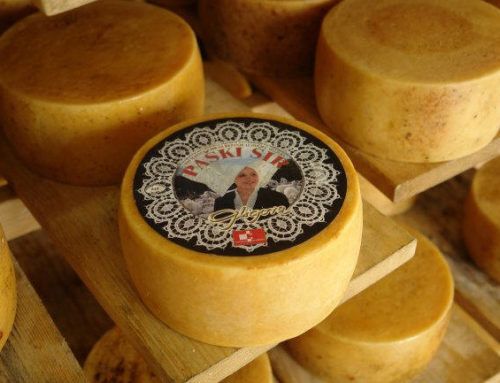The Roe to Health
In praise of all kinds of fish eggs, including caviar from the rivers of the American South.

When I think of fish eggs, caviar comes to mind—little black, salty berries reserved for only the most expensive parties or exclusive events. Caviar is the roe of the Beluga sturgeon, a prehistoric freshwater fish that has been swimming in rivers and lakes since the time of the dinosaurs. The most well-known Beluga caviar comes from the Caspian Sea. Until the breakup of the Soviet Union, two countries—the USSR and Iran—virtually controlled the caviar market, invested heavily in controlling and maintaining fish stocks. But with the collapse of Soviet Union came a weakening of regulations, so much so that some scientists believe overfishing and poaching is responsible for the 90 percent decline in the population of wild Beluga during the past two decades.
Russian caviar can cost as much as $100 an ounce, so it’s no wonder it’s oftentimes substituted with lumpfish roe, a bogus caviar that is dyed with a synthetic black azo dye only approved for lumpfish. This is a condiment worth avoiding. But since it is indistinguishable from the real thing by only the most experienced caviar connoisseur, it is the roe most likely presented on a fancy buffet table.
A better substitute for Russian caviar than lumpfish can be found close to home in the lakes and rivers of Arkansas. Arkansas caviar is harvested from the spoonbill or paddlefish members of the sturgeon family. Their berries are smoky-colored, not black, and they sell for an economical $20 per ounce. Some reports rate this caviar as good as, if not better, than Russian caviar.
I have always found the taste of Russian caviar extremely strong, and never really developed a liking for it. But I have discovered that there are many more palatable and affordable fish eggs to enjoy. In fact, there is whole world of fish eggs out there to discover.
Salmon roe has been treasured by many traditional cultures, especially the Eskimos, and is much more affordable and accessible than caviar. When Weston A. Price visited Eskimo tribes in the 1930s he recorded that they valued this high-nutrient food for its contribution to the health of their babies.
In Japan, salmon roe—called ikura—is an important ingredient in sushi. The sustained interest of the Japanese in the product is probably why this type of fish roe is readily available in the United States.
Another popular roe comes from flying fish. Sushi chefs use these little salmon-colored berries in California rolls—an Americanized sushi made with rice, avocado and flying fish roe rolled up in seaweed. American chefs commonly use fish eggs as garnish but only the most discerning diners value them enough to eat them. (Unfortunately, one of the ingredients of this variety of sushi is sarimi, which is imitation crab made from “modified fish protein” and containing many additives.)
Ann Lindberg/www.imagebank.sweden.se |
Some exotic roes include sea urchin roe, called uni by Japanese and scallop roe, which is only available frozen with the scallop. In Australia, scallop roe is called coral, probably due to its bright orange color. There are even roes harvested from freshwater fish of the Great Lakes. In Sweden, golden fish roe tops halved eggs with sour cream. Delicious!
The Italians value a dried roe called bottarga from the thin-lipped gray mullet. The best bottarga comes from the waters of Cabras Lake on the island of Sardinia. The whole egg sac (or pair) is preserved, dried and vacuum-sealed in plastic. Bottarga has a rich, tangy flavor ideal as an appetizer on top of a piece of bread, much like caviar on toasted pumpernickel. Often it is served grated or thinly sliced and tossed with pasta. If you would like to try it, contact an Italian market in your area to see whether they are willing to order it for you. Be sure to ask the purveyor if he can sell you a portion as two sacs from one fish can cost around $100.
I love carp roe, which can be found in Mediterranean or Middle Eastern stores, where it is usually labeled tarama. In olden times, tarama referred to the roe of various species of the gray mullet—especially the thin-lipped gray mullet like bottarga. The salmon-colored eggs were salted, washed, pressed, dried in the sun, and then encased in wax for sale. But that is not how you will find it packaged today. Dwindling supplies of gray mullet have probably been the impetus for the shift to carp roe, a less expensive source. Today, carp roe is usually preserved with salt and then packaged for sale in glass jars.
Tarama is seldom eaten in its pure form, but is routinely turned into caviar mayonnaise, a condiment called tarama after the roe, or alternatively taramasalata, the name favored by the Greeks. It is simply delicious. I first ate tarama at a Bulgarian picnic, and searched the crowd until I found the woman responsible for providing the mouth-watering dip in order to acquire the recipe. It is so simple to make and the perfect way to get your daily dose of roe.
Few people talk about the health benefits of eating roe—Weston A. Price is virtually unique in his insistence on the value of this superfood (although the French value caviar as an aphrodisiac). Roe is a rich source of vitamins A and D, very long-chain fatty acids, and zinc. Since deficiencies of all of these compounds during pregnancy can cause birth defects, it is a tribute to the wisdom of primitive peoples that they valued roe as a superfood, necessary for healthy children. Price noted that the Indians of the Andes went to great trouble to carry dried fish roe from sea level to high in the Andes, to provide those of childbearing age with a food that insured they would have healthy babies.
Most fresh caviars are preserved with salt only and are shipped and stored at 29-30°F to preserve freshness. Shelf-stable caviars in boxes or glass may contain small amounts of preservatives.
Tarama
Caviar Mayonnaise
This dip is common throughout the Mediterranean region. It is easy to make and great for parties. Some recipes call for the addition of white bread soaked in milk, probably to stretch the recipe, but this is unnecessary.
- 1 small onion, minced
- 1/2 cup carp roe
- 1 1/2 cup mild tasting olive oil
- juice of one large lemon
- 2 tsp. cold water
- salt to taste, if needed
Place roe and onion in a bowl and beat until blended, preferably with the whip attachment of a mixer. With the mixer running, slowly add the oil in a small stream. Keep beating until all the oil is used. Add lemon juice and beat. Add water to lighten; beat an additional minute. Since most commercial fish egg products are salted, only add additional salt if needed. Chill and serve with bread. Makes about 3 cups.
This article first appeared in the Spring 2002 issue of Wise Traditions, the quarterly journal of the Weston A. Price Foundation.

